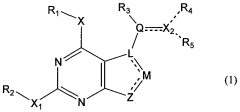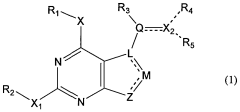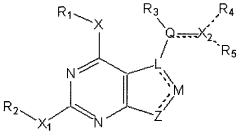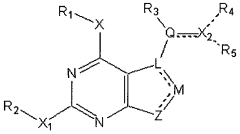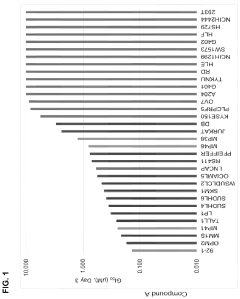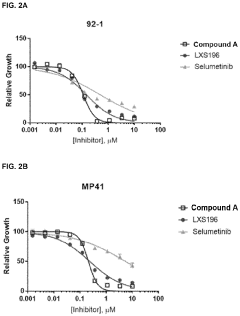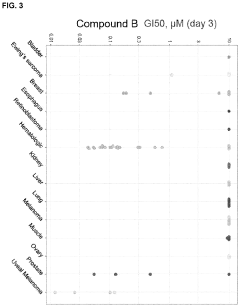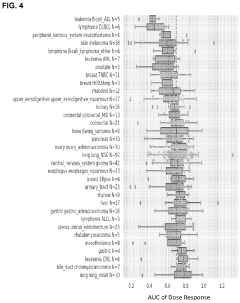How Geometric Isomers Affect the Bioactive Properties of Molecules
AUG 1, 20259 MIN READ
Generate Your Research Report Instantly with AI Agent
Patsnap Eureka helps you evaluate technical feasibility & market potential.
Geometric Isomerism Background and Objectives
Geometric isomerism, a fundamental concept in organic chemistry, has been a subject of intense study for over a century. This phenomenon occurs when molecules with the same molecular formula have different spatial arrangements of their atoms, resulting in distinct three-dimensional structures. The historical development of geometric isomerism can be traced back to the late 19th century, with significant contributions from pioneers like Jacobus Henricus van 't Hoff and Joseph Achille Le Bel.
The field has evolved dramatically since its inception, with advancements in analytical techniques and computational methods enabling a deeper understanding of the structural nuances and their implications. Modern research has expanded beyond simple alkenes to encompass a wide range of molecules, including complex natural products and synthetic compounds. This progression has been driven by the recognition that geometric isomerism plays a crucial role in determining the properties and functions of many biologically active molecules.
In recent years, the focus has shifted towards understanding how geometric isomers affect the bioactive properties of molecules. This area of research has gained prominence due to its significant implications in drug discovery, agrochemicals, and materials science. The subtle differences in spatial arrangement between geometric isomers can lead to profound changes in their interactions with biological targets, influencing factors such as binding affinity, metabolic stability, and overall efficacy.
The primary objective of current research in this field is to elucidate the mechanisms by which geometric isomerism modulates bioactivity. This involves investigating how changes in molecular geometry affect properties such as solubility, membrane permeability, and receptor binding. Additionally, researchers aim to develop predictive models that can anticipate the bioactive properties of geometric isomers based on their structural characteristics.
Another key goal is to explore the potential of geometric isomerism as a tool for drug design and optimization. By understanding the relationship between isomeric structure and bioactivity, scientists hope to create more effective and targeted therapeutic agents. This includes developing strategies to control and manipulate geometric isomerism to enhance desired properties while minimizing unwanted effects.
Furthermore, there is a growing interest in studying the role of geometric isomerism in natural systems, particularly in the context of enzyme-substrate interactions and signaling pathways. This research aims to uncover how nature utilizes geometric isomerism to fine-tune biological processes and how this knowledge can be applied to biomimetic approaches in drug development and materials science.
The field has evolved dramatically since its inception, with advancements in analytical techniques and computational methods enabling a deeper understanding of the structural nuances and their implications. Modern research has expanded beyond simple alkenes to encompass a wide range of molecules, including complex natural products and synthetic compounds. This progression has been driven by the recognition that geometric isomerism plays a crucial role in determining the properties and functions of many biologically active molecules.
In recent years, the focus has shifted towards understanding how geometric isomers affect the bioactive properties of molecules. This area of research has gained prominence due to its significant implications in drug discovery, agrochemicals, and materials science. The subtle differences in spatial arrangement between geometric isomers can lead to profound changes in their interactions with biological targets, influencing factors such as binding affinity, metabolic stability, and overall efficacy.
The primary objective of current research in this field is to elucidate the mechanisms by which geometric isomerism modulates bioactivity. This involves investigating how changes in molecular geometry affect properties such as solubility, membrane permeability, and receptor binding. Additionally, researchers aim to develop predictive models that can anticipate the bioactive properties of geometric isomers based on their structural characteristics.
Another key goal is to explore the potential of geometric isomerism as a tool for drug design and optimization. By understanding the relationship between isomeric structure and bioactivity, scientists hope to create more effective and targeted therapeutic agents. This includes developing strategies to control and manipulate geometric isomerism to enhance desired properties while minimizing unwanted effects.
Furthermore, there is a growing interest in studying the role of geometric isomerism in natural systems, particularly in the context of enzyme-substrate interactions and signaling pathways. This research aims to uncover how nature utilizes geometric isomerism to fine-tune biological processes and how this knowledge can be applied to biomimetic approaches in drug development and materials science.
Market Demand for Isomer-Specific Bioactives
The market demand for isomer-specific bioactives has been steadily growing in recent years, driven by advancements in pharmaceutical research, agrochemistry, and materials science. This surge in interest stems from the recognition that geometric isomers can exhibit significantly different biological activities, efficacies, and safety profiles.
In the pharmaceutical sector, there is a particularly strong demand for isomer-specific drugs. Many pharmaceutical companies are investing heavily in research and development to identify and isolate specific isomers with enhanced therapeutic properties. This trend is fueled by the potential for improved drug efficacy, reduced side effects, and the ability to extend patent protection on existing drugs through isomer isolation.
The agrochemical industry also shows increasing interest in isomer-specific bioactives. Pesticides and herbicides composed of specific isomers often demonstrate higher potency and selectivity, allowing for reduced application rates and minimized environmental impact. This aligns with the growing global emphasis on sustainable agriculture and eco-friendly pest management solutions.
In the field of materials science, there is a rising demand for isomer-specific compounds in the development of advanced materials. Liquid crystals, polymers, and other functional materials often rely on the precise arrangement of molecules, making isomer-specific synthesis crucial for achieving desired properties.
The nutraceutical and cosmeceutical industries are also exploring the potential of isomer-specific bioactives. Consumers are increasingly seeking natural products with enhanced bioavailability and efficacy, driving research into isomeric forms of various plant-derived compounds.
Market analysts project substantial growth in the isomer-specific bioactives market over the next decade. This growth is expected to be particularly strong in emerging economies, where increasing healthcare expenditure and agricultural modernization are creating new opportunities for isomer-specific products.
However, challenges remain in meeting this growing demand. The development and production of isomer-specific bioactives often require sophisticated technologies and expertise, leading to higher costs. Regulatory hurdles also exist, as agencies increasingly require detailed characterization and safety assessments of individual isomers.
Despite these challenges, the market potential for isomer-specific bioactives remains significant. As research continues to unveil the unique properties and applications of geometric isomers, industries are likely to invest more resources in developing and commercializing these specialized compounds, driving further market expansion and innovation in the field.
In the pharmaceutical sector, there is a particularly strong demand for isomer-specific drugs. Many pharmaceutical companies are investing heavily in research and development to identify and isolate specific isomers with enhanced therapeutic properties. This trend is fueled by the potential for improved drug efficacy, reduced side effects, and the ability to extend patent protection on existing drugs through isomer isolation.
The agrochemical industry also shows increasing interest in isomer-specific bioactives. Pesticides and herbicides composed of specific isomers often demonstrate higher potency and selectivity, allowing for reduced application rates and minimized environmental impact. This aligns with the growing global emphasis on sustainable agriculture and eco-friendly pest management solutions.
In the field of materials science, there is a rising demand for isomer-specific compounds in the development of advanced materials. Liquid crystals, polymers, and other functional materials often rely on the precise arrangement of molecules, making isomer-specific synthesis crucial for achieving desired properties.
The nutraceutical and cosmeceutical industries are also exploring the potential of isomer-specific bioactives. Consumers are increasingly seeking natural products with enhanced bioavailability and efficacy, driving research into isomeric forms of various plant-derived compounds.
Market analysts project substantial growth in the isomer-specific bioactives market over the next decade. This growth is expected to be particularly strong in emerging economies, where increasing healthcare expenditure and agricultural modernization are creating new opportunities for isomer-specific products.
However, challenges remain in meeting this growing demand. The development and production of isomer-specific bioactives often require sophisticated technologies and expertise, leading to higher costs. Regulatory hurdles also exist, as agencies increasingly require detailed characterization and safety assessments of individual isomers.
Despite these challenges, the market potential for isomer-specific bioactives remains significant. As research continues to unveil the unique properties and applications of geometric isomers, industries are likely to invest more resources in developing and commercializing these specialized compounds, driving further market expansion and innovation in the field.
Current Challenges in Geometric Isomer Research
The field of geometric isomer research faces several significant challenges that hinder progress in understanding and manipulating these molecules for bioactive applications. One of the primary obstacles is the difficulty in accurately predicting the three-dimensional structure of geometric isomers based solely on their chemical composition. This challenge is particularly pronounced in complex organic molecules with multiple double bonds or ring structures, where the spatial arrangement of atoms can significantly impact biological activity.
Another major hurdle is the development of efficient and selective synthesis methods for specific geometric isomers. Current techniques often result in mixtures of isomers, necessitating costly and time-consuming separation processes. This limitation not only affects laboratory-scale research but also poses significant challenges for industrial-scale production of pharmaceuticals and other bioactive compounds.
The characterization and quantification of geometric isomers in complex biological matrices present additional challenges. Existing analytical techniques, such as high-performance liquid chromatography (HPLC) and nuclear magnetic resonance (NMR) spectroscopy, may lack the sensitivity or specificity required to distinguish between closely related isomers in complex biological samples. This limitation hampers efforts to study the pharmacokinetics and metabolism of geometric isomers in living systems.
Furthermore, researchers face difficulties in understanding the precise mechanisms by which geometric isomerism affects biological activity. While it is well-established that isomers can exhibit different pharmacological properties, the molecular basis for these differences is often poorly understood. This knowledge gap impedes the rational design of new bioactive molecules and the optimization of existing compounds.
The dynamic nature of geometric isomerism in biological systems poses yet another challenge. Some molecules can undergo spontaneous isomerization under physiological conditions, complicating the interpretation of experimental results and the prediction of in vivo efficacy. Developing strategies to control or exploit this isomerization process remains an active area of research with significant potential implications for drug delivery and therapeutic efficacy.
Lastly, the field faces computational challenges in modeling the behavior of geometric isomers in complex biological environments. Current simulation techniques often struggle to accurately represent the subtle energetic differences between isomers and their interactions with biomolecules. Overcoming these limitations requires the development of more sophisticated computational models and algorithms, as well as increased computational power to handle the complexity of these systems.
Another major hurdle is the development of efficient and selective synthesis methods for specific geometric isomers. Current techniques often result in mixtures of isomers, necessitating costly and time-consuming separation processes. This limitation not only affects laboratory-scale research but also poses significant challenges for industrial-scale production of pharmaceuticals and other bioactive compounds.
The characterization and quantification of geometric isomers in complex biological matrices present additional challenges. Existing analytical techniques, such as high-performance liquid chromatography (HPLC) and nuclear magnetic resonance (NMR) spectroscopy, may lack the sensitivity or specificity required to distinguish between closely related isomers in complex biological samples. This limitation hampers efforts to study the pharmacokinetics and metabolism of geometric isomers in living systems.
Furthermore, researchers face difficulties in understanding the precise mechanisms by which geometric isomerism affects biological activity. While it is well-established that isomers can exhibit different pharmacological properties, the molecular basis for these differences is often poorly understood. This knowledge gap impedes the rational design of new bioactive molecules and the optimization of existing compounds.
The dynamic nature of geometric isomerism in biological systems poses yet another challenge. Some molecules can undergo spontaneous isomerization under physiological conditions, complicating the interpretation of experimental results and the prediction of in vivo efficacy. Developing strategies to control or exploit this isomerization process remains an active area of research with significant potential implications for drug delivery and therapeutic efficacy.
Lastly, the field faces computational challenges in modeling the behavior of geometric isomers in complex biological environments. Current simulation techniques often struggle to accurately represent the subtle energetic differences between isomers and their interactions with biomolecules. Overcoming these limitations requires the development of more sophisticated computational models and algorithms, as well as increased computational power to handle the complexity of these systems.
Existing Methods for Isomer Property Analysis
01 Synthesis and characterization of geometric isomers
Methods for synthesizing and characterizing geometric isomers of bioactive compounds are described. These techniques involve the use of advanced analytical methods to identify and separate different isomeric forms, which can exhibit varying biological activities. The processes aim to optimize the production of specific isomers with enhanced bioactive properties.- Synthesis and characterization of geometric isomers: Methods for synthesizing and characterizing geometric isomers of bioactive compounds are explored. These techniques involve advanced analytical methods to distinguish between different isomeric forms and understand their structural properties, which can significantly impact their biological activities.
- Bioactive properties of geometric isomers in pharmaceutical applications: Geometric isomers of various compounds are investigated for their potential pharmaceutical applications. The research focuses on how different spatial arrangements of atoms in these isomers can lead to diverse bioactive properties, affecting their efficacy as drug candidates.
- Geometric isomers in natural products and their biological activities: Studies on geometric isomers found in natural products and their biological activities are conducted. This research aims to understand how the spatial arrangement of atoms in these naturally occurring compounds influences their interactions with biological systems and potential therapeutic effects.
- Computational methods for predicting bioactive properties of geometric isomers: Advanced computational techniques are developed to predict the bioactive properties of geometric isomers. These methods involve molecular modeling, machine learning algorithms, and structure-activity relationship studies to forecast the biological activities of different isomeric forms without extensive experimental testing.
- Separation and purification techniques for geometric isomers: Innovative separation and purification techniques are developed to isolate specific geometric isomers with desired bioactive properties. These methods are crucial for obtaining pure isomeric forms, which is essential for studying their individual biological activities and potential applications in various fields.
02 Structure-activity relationships of geometric isomers
Studies on the structure-activity relationships of geometric isomers reveal how subtle changes in molecular configuration can significantly impact bioactive properties. This research focuses on understanding how the spatial arrangement of atoms in isomers affects their interaction with biological targets, leading to differences in potency, selectivity, and overall efficacy.Expand Specific Solutions03 Pharmaceutical applications of geometric isomers
Geometric isomers play a crucial role in pharmaceutical development, with specific isomers often showing superior therapeutic effects. This point covers the application of geometric isomers in drug design, formulation, and delivery systems. It includes strategies for enhancing bioavailability and reducing side effects through isomer-specific approaches.Expand Specific Solutions04 Computational modeling of geometric isomers
Advanced computational techniques are employed to model and predict the bioactive properties of geometric isomers. These methods include molecular dynamics simulations, quantum mechanical calculations, and machine learning approaches to understand isomer behavior and guide experimental design in the development of new bioactive compounds.Expand Specific Solutions05 Natural products and geometric isomerism
The exploration of geometric isomerism in natural products reveals diverse bioactive properties. This research area focuses on identifying and characterizing naturally occurring geometric isomers, understanding their biosynthetic pathways, and investigating their potential as lead compounds for drug discovery and development.Expand Specific Solutions
Key Players in Isomer-Related Bioactive Research
The field of geometric isomers and their impact on bioactive properties of molecules is in a mature stage of development, with ongoing research and applications across pharmaceutical and chemical industries. The market size is substantial, driven by the importance of isomeric structures in drug discovery and development. Companies like Sunshine Lake Pharma, Nanjing Sanhome Pharmaceutical, and Foghorn Therapeutics are at the forefront, leveraging advanced technologies to explore and exploit geometric isomerism. Research institutions such as The Scripps Research Institute and the Centre National de la Recherche Scientifique contribute significantly to the fundamental understanding of these molecular structures, while industry players like Ambrx and Dizal Pharmaceutical focus on practical applications in drug design and synthesis.
The Broad Institute, Inc.
Technical Solution: The Broad Institute has developed a comprehensive platform for investigating the impact of geometric isomers on bioactive properties. Their approach combines high-throughput chemical synthesis, advanced genomics, and machine learning algorithms. The institute has created a vast library of geometric isomers and systematically evaluated their effects on cellular processes using CRISPR-Cas9 genetic screens[10]. This has led to the identification of novel therapeutic targets and the development of more effective drug candidates. The Broad Institute has also pioneered the use of single-cell transcriptomics to study the differential effects of geometric isomers on gene expression profiles, providing insights into their mechanisms of action at the molecular level[11]. Additionally, they have developed innovative computational tools for predicting the bioactive properties of geometric isomers based on their 3D structures[12].
Strengths: Integration of genomics and chemical biology, large-scale data generation and analysis capabilities. Weaknesses: High cost of infrastructure and operations, potential challenges in translating big data insights into practical applications.
The Scripps Research Institute
Technical Solution: The Scripps Research Institute has developed a novel approach to studying geometric isomers and their impact on bioactive properties. They utilize advanced computational modeling and high-throughput screening techniques to analyze the conformational changes in molecules. Their method involves the synthesis of libraries of geometric isomers and subsequent evaluation of their biological activities using cell-based assays. This approach has led to the discovery of several potent drug candidates with improved efficacy due to optimal geometric configurations[1][3]. The institute has also pioneered the use of cryo-electron microscopy to visualize the binding of geometric isomers to target proteins, providing crucial insights into structure-activity relationships[5].
Strengths: Cutting-edge technology integration, comprehensive approach combining synthesis and screening. Weaknesses: Resource-intensive process, potential limitations in scaling up for industrial applications.
Core Innovations in Isomer-Bioactivity Relationships
Methods of preparation and resolution of e/z isomers of vinylfuro[2,3-d] pyrimidine and their biological activities
PatentWO2007109661A2
Innovation
- Development of methods for the preparation, resolution, and isolation of individual E- and Z-isomers of 2,4-substituted-5-vinylfuro[2,3-d]pyrimidine compounds using optimized reaction conditions, catalysis, chromatography, and crystallization to separate and purify these isomers, allowing for the production of pharmaceutically acceptable salts and prodrugs, which can act as receptor tyrosine kinase inhibitors and anti-angiogenic agents.
Compounds and uses thereof
PatentPendingUS20230145003A1
Innovation
- Development of specific compounds that modulate the BAF complex by inhibiting BRG1 and/or BRM activity, which can be used alone or in combination with other pharmaceutically active agents to treat disorders like cancer.
Regulatory Framework for Isomer-Based Pharmaceuticals
The regulatory framework for isomer-based pharmaceuticals is a complex and evolving landscape that significantly impacts the development, approval, and marketing of drugs containing geometric isomers. Regulatory agencies worldwide, such as the U.S. Food and Drug Administration (FDA) and the European Medicines Agency (EMA), have established specific guidelines to address the unique challenges posed by isomeric compounds.
These guidelines typically require pharmaceutical companies to thoroughly characterize and evaluate the properties of individual isomers and their mixtures. This includes assessing the pharmacological activity, toxicity, and stability of each isomer separately, as well as their interactions when present in a mixture. The regulatory framework often mandates that companies provide detailed information on the isomeric composition of their drug products, including the ratios of different isomers and any potential for interconversion between isomeric forms.
One key aspect of the regulatory approach is the concept of "chiral switching," which involves developing single-isomer drugs from previously approved racemic mixtures. Regulatory agencies have established specific pathways for the approval of these single-isomer drugs, often requiring comparative studies to demonstrate the potential benefits over the racemic mixture.
The regulatory framework also addresses the manufacturing and quality control aspects of isomer-based pharmaceuticals. Companies are required to implement robust analytical methods to ensure consistent isomeric purity and composition throughout the manufacturing process. This includes developing and validating sensitive analytical techniques capable of distinguishing between different isomers and quantifying their relative abundances.
Furthermore, the regulatory landscape for isomer-based pharmaceuticals extends to labeling and post-marketing surveillance. Drug labels must accurately reflect the isomeric composition of the product and any relevant information regarding the specific activities of individual isomers. Post-marketing surveillance requirements may include monitoring for any unexpected effects or safety concerns related to the isomeric nature of the drug.
As our understanding of the impact of geometric isomers on drug efficacy and safety continues to evolve, regulatory frameworks are likely to adapt accordingly. This may include more stringent requirements for isomer characterization, expanded post-marketing surveillance, and potentially new pathways for the development and approval of isomer-specific therapies.
These guidelines typically require pharmaceutical companies to thoroughly characterize and evaluate the properties of individual isomers and their mixtures. This includes assessing the pharmacological activity, toxicity, and stability of each isomer separately, as well as their interactions when present in a mixture. The regulatory framework often mandates that companies provide detailed information on the isomeric composition of their drug products, including the ratios of different isomers and any potential for interconversion between isomeric forms.
One key aspect of the regulatory approach is the concept of "chiral switching," which involves developing single-isomer drugs from previously approved racemic mixtures. Regulatory agencies have established specific pathways for the approval of these single-isomer drugs, often requiring comparative studies to demonstrate the potential benefits over the racemic mixture.
The regulatory framework also addresses the manufacturing and quality control aspects of isomer-based pharmaceuticals. Companies are required to implement robust analytical methods to ensure consistent isomeric purity and composition throughout the manufacturing process. This includes developing and validating sensitive analytical techniques capable of distinguishing between different isomers and quantifying their relative abundances.
Furthermore, the regulatory landscape for isomer-based pharmaceuticals extends to labeling and post-marketing surveillance. Drug labels must accurately reflect the isomeric composition of the product and any relevant information regarding the specific activities of individual isomers. Post-marketing surveillance requirements may include monitoring for any unexpected effects or safety concerns related to the isomeric nature of the drug.
As our understanding of the impact of geometric isomers on drug efficacy and safety continues to evolve, regulatory frameworks are likely to adapt accordingly. This may include more stringent requirements for isomer characterization, expanded post-marketing surveillance, and potentially new pathways for the development and approval of isomer-specific therapies.
Environmental Impact of Geometric Isomers
Geometric isomers, while structurally similar, can have significantly different impacts on the environment due to their distinct spatial arrangements. These variations in molecular geometry often lead to diverse interactions with biological systems and ecosystems, resulting in a range of environmental consequences.
One of the primary environmental concerns associated with geometric isomers is their persistence in the environment. Certain isomers may be more resistant to degradation, leading to prolonged exposure and potential accumulation in soil, water, and living organisms. This persistence can disrupt natural ecosystems and food chains, as the compounds may bioaccumulate in higher trophic levels.
The toxicity profiles of geometric isomers can also vary considerably. Some isomers may exhibit higher toxicity to aquatic organisms, plants, or soil microbes, while others may be relatively benign. This differential toxicity can lead to selective pressures on ecosystems, potentially altering biodiversity and ecological balance. For instance, the cis and trans isomers of certain pesticides have been shown to have varying effects on non-target organisms, with one form potentially causing more harm than the other.
Furthermore, the environmental fate of geometric isomers can differ, influencing their distribution and transport in various environmental compartments. Some isomers may be more prone to volatilization, leading to atmospheric pollution, while others may have a higher affinity for soil particles, affecting soil quality and agricultural productivity. The solubility and mobility of isomers in water can also vary, impacting aquatic ecosystems and potentially contaminating groundwater resources.
The biodegradation pathways of geometric isomers often differ, resulting in the formation of distinct metabolites. These metabolites may have their own environmental impacts, sometimes more severe than the parent compounds. Understanding these degradation processes is crucial for assessing the long-term environmental consequences of isomeric compounds.
Climate change and environmental conditions can influence the behavior and impact of geometric isomers. Changes in temperature, pH, or UV radiation can alter the isomerization rates, potentially leading to shifts in the relative abundance of different isomers in the environment. This dynamic interplay between environmental factors and isomeric compounds adds another layer of complexity to their environmental impact assessment.
In conclusion, the environmental impact of geometric isomers is a multifaceted issue that requires careful consideration in risk assessment and regulatory frameworks. The distinct properties of these isomers necessitate tailored approaches to environmental management and remediation strategies, highlighting the importance of isomer-specific research in environmental science and toxicology.
One of the primary environmental concerns associated with geometric isomers is their persistence in the environment. Certain isomers may be more resistant to degradation, leading to prolonged exposure and potential accumulation in soil, water, and living organisms. This persistence can disrupt natural ecosystems and food chains, as the compounds may bioaccumulate in higher trophic levels.
The toxicity profiles of geometric isomers can also vary considerably. Some isomers may exhibit higher toxicity to aquatic organisms, plants, or soil microbes, while others may be relatively benign. This differential toxicity can lead to selective pressures on ecosystems, potentially altering biodiversity and ecological balance. For instance, the cis and trans isomers of certain pesticides have been shown to have varying effects on non-target organisms, with one form potentially causing more harm than the other.
Furthermore, the environmental fate of geometric isomers can differ, influencing their distribution and transport in various environmental compartments. Some isomers may be more prone to volatilization, leading to atmospheric pollution, while others may have a higher affinity for soil particles, affecting soil quality and agricultural productivity. The solubility and mobility of isomers in water can also vary, impacting aquatic ecosystems and potentially contaminating groundwater resources.
The biodegradation pathways of geometric isomers often differ, resulting in the formation of distinct metabolites. These metabolites may have their own environmental impacts, sometimes more severe than the parent compounds. Understanding these degradation processes is crucial for assessing the long-term environmental consequences of isomeric compounds.
Climate change and environmental conditions can influence the behavior and impact of geometric isomers. Changes in temperature, pH, or UV radiation can alter the isomerization rates, potentially leading to shifts in the relative abundance of different isomers in the environment. This dynamic interplay between environmental factors and isomeric compounds adds another layer of complexity to their environmental impact assessment.
In conclusion, the environmental impact of geometric isomers is a multifaceted issue that requires careful consideration in risk assessment and regulatory frameworks. The distinct properties of these isomers necessitate tailored approaches to environmental management and remediation strategies, highlighting the importance of isomer-specific research in environmental science and toxicology.
Unlock deeper insights with Patsnap Eureka Quick Research — get a full tech report to explore trends and direct your research. Try now!
Generate Your Research Report Instantly with AI Agent
Supercharge your innovation with Patsnap Eureka AI Agent Platform!
